Uncovering the multi-target pharmacological mechanism of Xuebijing injection against sepsis by a systems pharmacology approach
2021-02-04PingWangJingjingZhuJieZhaiXiaoruiLiHongcaiShangJianxunWang
Ping Wang,Jingjing Zhu,Jie Zhai,Xiaorui Li,Hongcai Shang,Jianxun Wang*
1 School of Life Sciences,Beijing University of Chinese Medicine,Beijing 100029,China.
2 Key Laboratory of Chinese Internal Medicine of Ministry of Education and Beijing,Dongzhimen Hospital,Beijing University of Chinese Medicine,Beijing 100700,China.
Abstract Sepsis is a life-threatening organ dysfunction that is associated with a high risk of death.Xuebijing (XBJ)injection,a Chinese herbal compound preparation,has been widely used for the treatment of sepsis in China.The purpose of this research is to decipher the underlying multi-target pharmacological mechanism of XBJ in the treatment of sepsis using a systems pharmacology approach.Compounds in XBJ were collected by literature retrieval.The corresponding putative targets of XBJ were screened from the Traditional Chinese Medicine Systems Pharmacology (TCMSP),Swiss Target Prediction (STP),and Search Tool for Interacting Chemicals(STITCH) databases.Sepsis-related targets were summarized using the Genecards,DrugBank,and Online Mendelian Inheritance in Man (OMIM) databases.The intersection targets were obtained with Venny 2.1.Subsequently,protein-protein interaction (PPI) networks were constructed with the STRING database and Cytoscape 3.7.1.Then,degree,betweenness,and closeness were calculated to recognize the core targets in the PPI network.Moreover,the pharmacological mechanism of XBJ against sepsis was predicted via gene ontology(GO) and Kyoto Encyclopedia of Genes and Genomes (KEGG) enrichment.After the literature review,the 33 most commonly cited chemical ingredients,were screened out as major compounds.Bioinformatics analysis revealed that the major compounds of XBJ modulated 218 common targets associated with sepsis.Through PPI network analysis,41 genes,including IL-6,AKT1,STAT3,TP53,and MAPK1,were identified as core targets.The results of GO and KEGG enrichment revealed that the potential biological functions of XBJ against sepsis were mainly involved in cytokine receptor binding,cytokine activity,growth factor receptor binding,growth factor activity,and chemokine activity.The crucial pathways were closely associated with initial immune activation (CLR/TLR4-NF-κB/MAPK pathway),the acute inflammatory response (TNFMAPK/caspase and IL-MAPK/STAT pathways),and the late inflammation and coagulation process (HMGB1-RAGE and HIF-1 signaling pathways).This study revealed that the multiple components of XBJ exert multitarget effects against sepsis by regulating initial immune activation,the acute inflammatory response,and the late inflammation and coagulation process.
Keywords: Xuebijing,Sepsis,Multi-target,Mechanism,Systems pharmacology
Background
Sepsis is a life-threatening organ dysfunction that is caused by a dysregulated host response to infection and represents a major health-care problem worldwide [1,2].Recently,48.9 million cases and 11.0 million sepsisrelated deaths were reported in high-income countries,representing 19.7% of all global deaths [3].In mainland China,sepsis affects one-fifth of patients admitted to ICUs,with a 90-day mortality rate of 35.5% [4].The pathogenesis of sepsis syndrome is associated with an initial immune activation in response to infection [5].Infection,which is caused by bacteria or viruses,triggers a cascade of inflammatory cytokines and chemokines that result in the activation of coagulation[6].An overwhelming inflammatory response and coagulation lead to apoptosis and tissue ischaemia,which progresses to sepsis-induced organ dysfunction[7,8].Although many advances have been made in our understanding of the host response to infection,empiric antimicrobial therapy and supportive care remain the cornerstones of the treatment; no Federal Drug Administration (FDA)-approved drug exists for this highly lethal condition [9,10].
Xuebijing (XBJ) injection,a Chinese herbal compound preparation,has been widely applied for the clinical treatment of sepsis in China [11].XBJ is composed of five Chinese herbs: Honghua (Carthami Flos),Chishao (Radix Paeoniae Rubra),Chuanxiong(Chuanxiong Rhizoma),Danshen (Radix Salviae) and Danggui (Angelicae Sinensis Radix).It has the functions of activating circulation,removing blood stasis,and clearing toxins according to traditional Chinese medicine (TCM) theory.In recent decades,accumulating evidence suggested that XBJ is effective for improving the outcomes of critically ill patients with serious lung infections and sepsis [12,13].In the current COVID-19 pandemic,XBJ has played an active role in improving lung injury in patients with severe infection by inhibiting the expression of proinflammatory cytokines,and it was recommended in the SARS-CoV-2 guideline [14,15].The mechanism by which XBJ protects against sepsis involves antiinflammatory,immunomodulatory,anti-oxidant,and anti-coagulation effects [16-19].However,previous studies mostly focused on a single compound or a single pathway,which does not reflect the mechanism of the multi-compound,multi-target,and multi-channel system of Chinese herbal medicine.
Network pharmacology,which is first introduced by Hopkins,has been proven to be an effective approach for deciphering the complex pharmacological mechanisms of Chinese herbal medicines [20-22].It combines the concepts and methods of bioinformatics,cheminformatics,and systems biology to systematically explore the effects of herbs,which is consistent with the integrated and systematic nature of TCM theory.To our knowledge,only one study has previously investigated the mechanism of XBJ for the treatment of sepsis with the network pharmacology method [23].In that study,the predicted targets relied exclusively on a single database,and only 8 common targets were obtained.Besides,a master's thesis investigated the mechanism of XBJ for the treatment of sepsis with the metabolomics and bioinformatics method [24].But,they were more focus on the metabolites.So that,these two studies are difficult to guarantee the results are comprehensive.Therefore,a systematic investigation to clarify the complex pharmacological mechanism of XBJ in the treatment of sepsis is urgently needed.
In the present work,we systematically reviewed the major compounds of XBJ through a literature search and adopted six databases to predict related targets,aiming to systematically reveal the underlying multitarget pharmacological mechanism of XBJ in the treatment of sepsis via the application of a network pharmacology strategy.The detailed workflow of our research is illustrated in Figure 1.
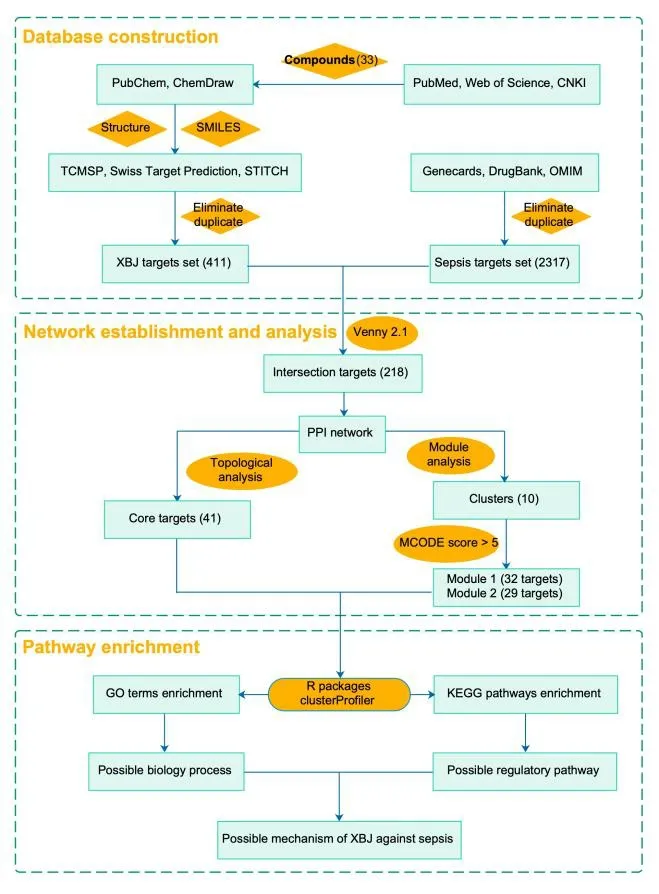
Figure 1.Workflow of the network pharmacologybased strategy for deciphering the multi-target pharmacological mechanism of XBJ against sepsis.
Methods
Database construction
Building a chemical ingredient databaseTo collect the chemical ingredients of XBJ,an electronic search in PubMed (https://www.ncbi.nlm.nih.gov/pubmed/),Web of Science (http://apps.webofknowledge.com/),and China National Knowledge Infrastructure (CNKI,http://www.cnki.net/) for related literature published in the last 5 years (2015-2020) was conducted.Furthermore,PubChem(https://pubchem.ncbi.nlm.nih.gov/) and ChemDraw(http://www.chemdraw.com.cn/) were used to obtain the canonical simplified molecular input line entry specification (SMILES) and structural information of the major compounds.
Screening putative targets of XBJUsing the onlineaccessible databases of Traditional Chinese Medicine Systems Pharmacology Database (TCMSP)(https://tcmspw.com/tcmsp.php),Swiss Target Prediction (http://www.swisstargetprediction.ch/) and the Search Tool for Interacting Chemicals (STITCH)(http://stitch.embl.de/),which are widely used in research on the relationships between herbal ingredients and potential therapeutic targets [25-27],all reported pharmacological targets of XBJ were obtained,with the species limited to “Homo sapiens”.To improve the reliability of the results,we removed the targets with probabilities less than 0.2 in the Swiss Target Prediction database.Since TCMSP and STITCH databases have no possibility parameters,all reported pharmacological targets in these two database were included.Subsequently,we acquired the common gene names of the targets from the UniProt(https://www.uniprot.org/) database and then eliminated duplicate genes.
Prediction of sepsis-related targetsSepsis-related targets were acquired from the Genecards,DrugBank,and Online Mendelian Inheritance in Man (OMIM)databases.Genecards (http://www.genecards.org/) is a database of genes,their corresponding products,and their biomedical applications [28].DrugBank(https://www.drugbank.ca/) is a comprehensive bioinformatics and cheminformatics resource that pairs drug and target information in an encyclopaedic manner [29].OMIM (http://www.omim.org/) is a continuously updated database of human genes and genetic disorders [30].“Sepsis” was used as the key word.The search conditions were set to “gene” and“Homo sapiens”.
Network establishment and analysis
Protein-protein interaction dataTo identify the overlapping targets,the intersection between the XBJrelated and sepsis-related targets was assayed and visualized with Venny 2.1(http://bioinformatics.psb.ugent.be/webtools/Venn/).Subsequently,the overlapping targets were submitted to the STRING 11.0 database (https://string-db.org/) to obtain the potential inter-protein interactions (PPIs).Only “Homo sapiens” proteins with confidence scores higher than 0.7 were selected after hiding the disconnected nodes.
Network construction and topological analysisThe graphical interactions of the PPI network were visualized in Cytoscape software (Version 3.7.2).The topological parameters in the network were evaluated using the Network Analyzer Tool in Cytoscape.The core targets were selected and identified based on their topological parameters,such as degree,betweenness,and closeness.The degree is defined as the number of edges connected to a node .The betweenness represents how often a node lies on the shortest paths that go through a given node.The closeness represents the reciprocal of the sum of the distances from one node to another.In the present work,only nodes with three topological parameters higher than the corresponding median values were identified as core targets.
Module analysisMoreover,the dense regions of interaction in the PPI network was identified using Molecular COmplex DEtection (MCODE) plugin based on complex connection data.The following default parameters of MCODE: Degree Cutoff = 2;Node Score Cutoff = 0.2; K-Core = 2; and Max.Depth= 100.MCODE scores > 5 were used to identify core modules.
Functional enrichment analysis
Functional analysis,including Gene Ontology (GO)and Kyoto Encyclopedia of Genes and Genomes(KEGG) pathway enrichment,of the identified core targets and core modules,respectively,was performed using the R package clusterProfiler (version 3.6.2).The downloaded results (p value < 0.05 and q value < 0.05)were reported using the p value and count value.According to -Log10(p values),the top 10 biological functions and pathways were selected as significant entries.
Construction of the compound-target-pathway network
To further explore the multi-scale molecular mechanism of XBJ against sepsis,a “compound-targetpathway” network was constructed with Cytoscape software.In this network,the nodes included pathways,associated core targets and major compounds,which have different shapes and colors.The topological parameters of the node degree in the network were also analyzed with a network analyzer.Then,the core compounds and the corresponding common targets were obtained through the network.An overview of the potential targets and pathways of XBJ against sepsis is illustrated.
Results
Major compounds and putative targets of XBJ
We identified 10 publications on the components of XBJ in the literature search,including 5 publications in English and 5 publications in Chinese [31-40].In addition,Song et al.reported the chemical composition of XBJ in a supplementary file [13].After reading the full text of the publications and removing duplicates,a total of 33 chemical ingredients referred to by two or more articles were screened out as major compounds(Table 1).Among them,the most commonly cited compounds were hydroxysafflor yellow A,ferulic acid,oxypaeoniflorin,albiflorin,and paeoniflorin.The chemical structures of the major compounds of XBJ are illustrated in Figure 2.
The corresponding targets of the major compounds were screened through the TCMSP database.A total of 248 potential targets were collected after transformation via the UniProt database.Moreover,the Swiss Target Prediction and STITCH databases were also manually searched in the SMILES format to complement the results from the TCMSP.Ultimately,134 and 118 potential targets were collected from the Swiss Target Prediction and STITCH databases,respectively.In total,411 putative targets of XBJ were obtained after eliminating duplicates.Detailed information about the potential targets of XBJ is shown in Supplementary Table S1.
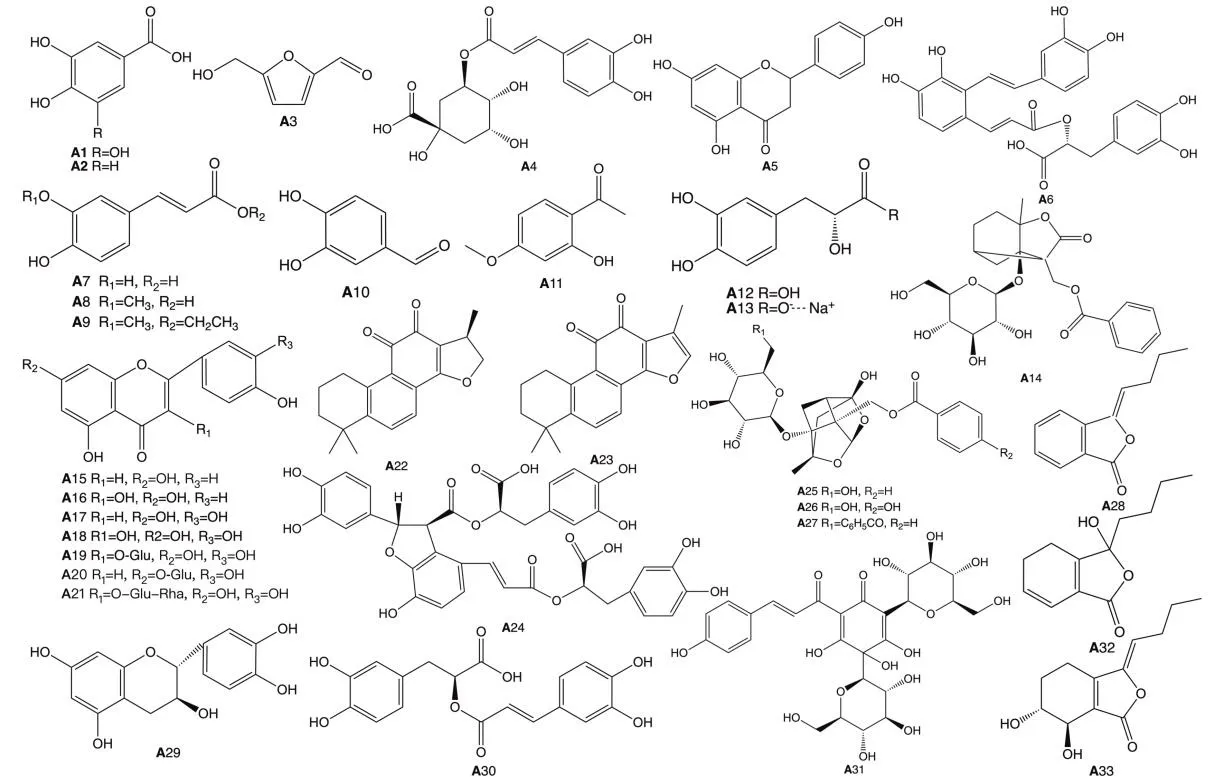
Figure 2.The chemical structures of the major compounds in Xuebijing injection.

Table 1 The major compounds of Xuebijing injection
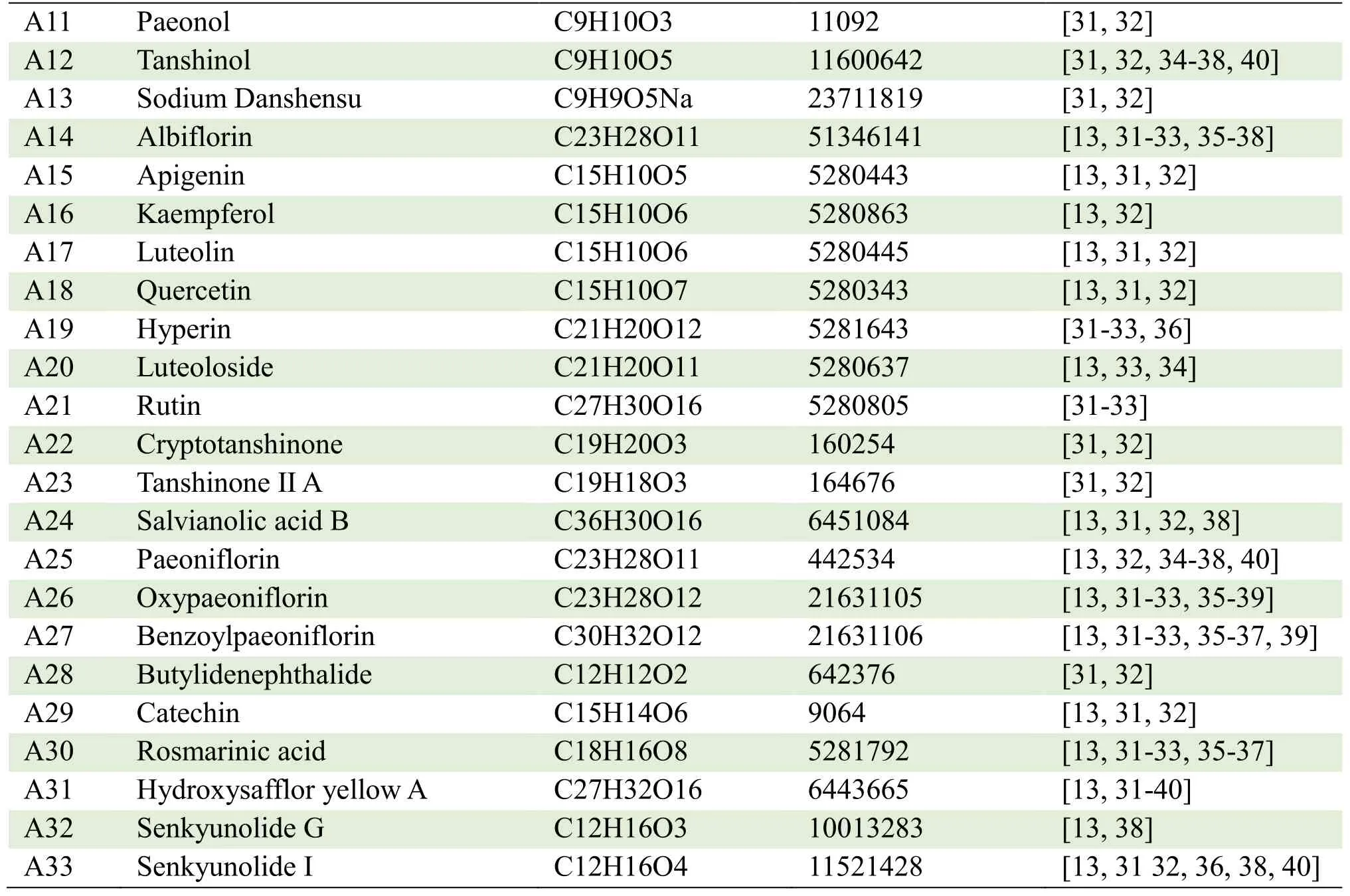
A11 Paeonol C9H10O3 11092 [31,32]A12 Tanshinol C9H10O5 11600642[31,32,34-38,40]A13 Sodium Danshensu C9H9O5Na 23711819 [31,32]A14 Albiflorin C23H28O11 51346141[13,31-33,35-38]A15 Apigenin C15H10O5 5280443 [13,31,32]A16 Kaempferol C15H10O6 5280863[13,32]A17 Luteolin C15H10O6 5280445 [13,31,32]A18 Quercetin C15H10O7 5280343[13,31,32]A19 Hyperin C21H20O12 5281643 [31-33,36]A20 Luteoloside C21H20O11 5280637[13,33,34]A21 Rutin C27H30O16 5280805 [31-33]A22 Cryptotanshinone C19H20O3 160254[31,32]A23 Tanshinone II A C19H18O3 164676 [31,32]A24 Salvianolic acid B C36H30O16 6451084[13,31,32,38]A25 Paeoniflorin C23H28O11 442534 [13,32,34-38,40]A26 Oxypaeoniflorin C23H28O12 21631105[13,31-33,35-39]A27 Benzoylpaeoniflorin C30H32O12 21631106 [13,31-33,35-37,39]A28 Butylidenephthalide C12H12O2 642376[31,32]A29 Catechin C15H14O6 9064 [13,31,32]A30 Rosmarinic acid C18H16O8 5281792[13,31-33,35-37]A31 Hydroxysafflor yellow A C27H32O16 6443665 [13,31-40]A32 Senkyunolide G C12H16O3 10013283[13,38]A33 Senkyunolide I C12H16O4 11521428 [13,31 32,36,38,40]
Sepsis-related targets and overlapping targets of XBJ/sepsis
By employing the online databases Genecards,DrugBank,and OMIM,a total of 2317 sepsis-related targets (2316,2 and 1 sepsis-related targets were collected from Genecards,DrugBank,and OMIM,respectively) were obtained after eliminating redundant entries (listed in Supplementary Table S2).We used Venny 2.1,an online-accessible tool,to plot the Venn diagram,after which 218 overlapping targets were obtained (Figure 3A).Detailed information on these overlapping targets is shown in Supplementary Table S3.
Network construction and analysis
The PPI network containing 214 nodes and 2166 edges was constructed.Then,the topological parameters of each node in the PPI network were calculated with the Network Analyzer Tool in Cytoscape.Consequently,41 nodes with a degree value > 20,betweenness > 0.0067 and closeness > 0.4271 were identified as core targets(Table 2,Figure 3B).The specific information on the topological parameters of each node is shown in Supplemental Table S3.To improve the analysis of the PPI network,the dense regions of the network were identified using the MCODE tool in Cytoscape.As a result,the PPI network was divided into 10 clusters(Supplementary Figure S1).Module 1 and Module 2 with scores of 20.90 and 8.36,respectively,were selected as core modules.A total of 30 core targets belonged to these 2 modules (Figure 3C and D).Among them,the top 10 targets with the highest node degree were as follows: IL6,AKT1,STAT3,TP53,MAPK1,TNF,INS,VEGFA,JUN,and MAPK8 (Table 2).

Figure 3.PPI network of XBJ in sepsis.(A) Venn diagram of XBJ and sepsis targets.(B) Forty-one core target interactions in the PPI network.(C and D) Top two modules of the PPI network: (C) Module 1 and (D)Module 2,and the circular nodes marked in purple represent core targets contained in (B).
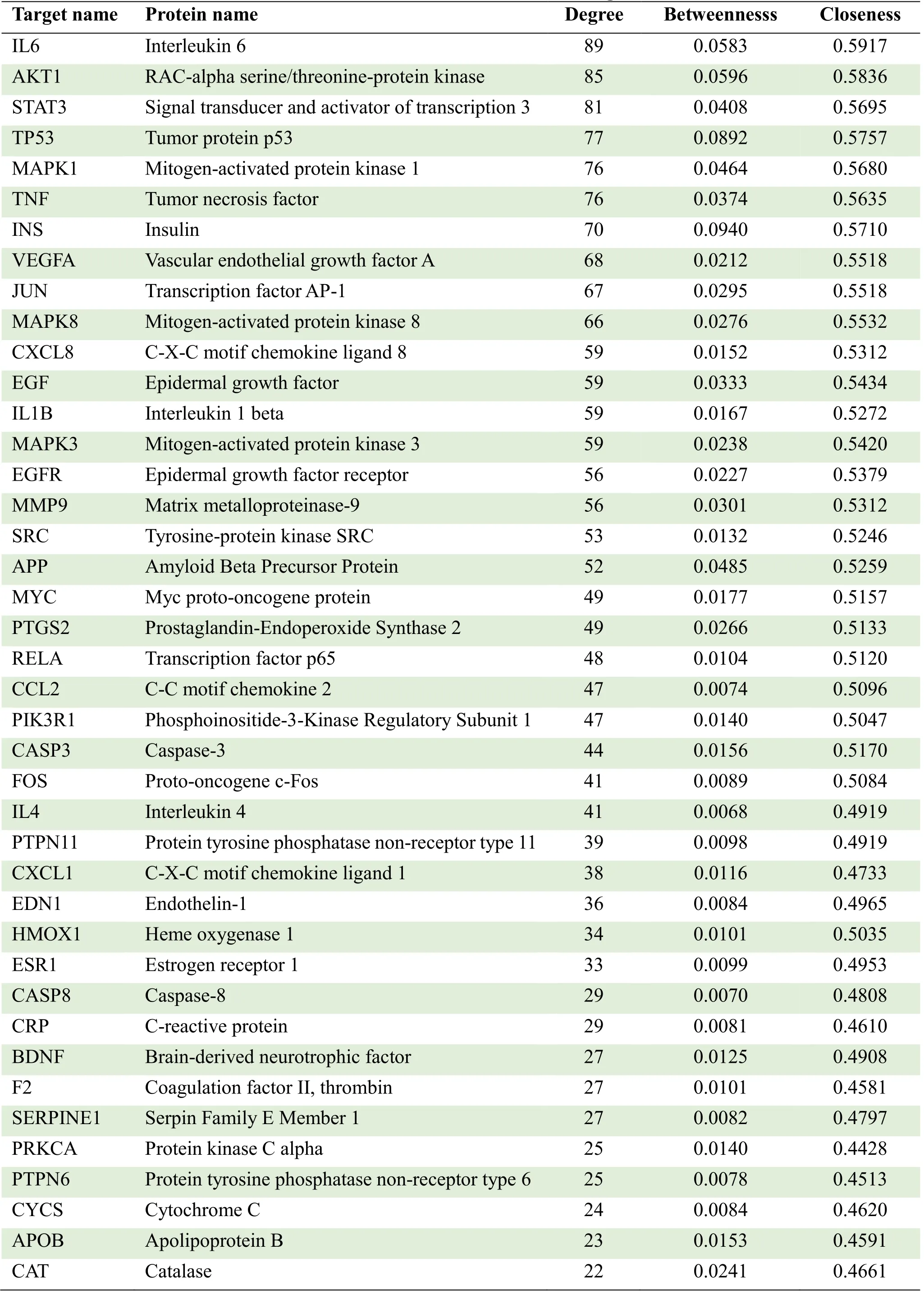
Table 2 Information on the 41 core targets
GO biological functions and KEGG pathway enrichment
Following R-language analyses,the GO biological functions and KEGG pathway enrichment of the 41 core targets were analyzed and illustrated.As shown in Figure 4A,the biological functions of the core targets were mainly involved in cytokine receptor binding,receptor ligand activity,cytokine activity,growth factor receptor binding,and phosphotyrosine residue binding(Supplemental Table S4).In the KEGG enrichment analysis,a total of 161 pathways and diseases were obtained.The core target-related diseases were mainly viral and bacterial infectious diseases (Supplementary Figure S2).The core target-related pathways were mainly related to inflammation,transcription,and immune recognition,such as the TNF signaling pathway,MAPK signaling pathway,and Toll-like receptor signaling pathway (Figure 4B,Supplementary Table S5).
Next,we performed GO and KEGG enrichment analysis of the 2 identified core modules to gain insights into the multiscale molecular mechanism of XBJ against sepsis.Similar to the core targets,the biological functions of Module 1 were highly correlated with cytokine activity and cytokine receptor binding functions (Figure 4C,Supplementary Table S4).The pathways of Module 1 were mainly related to inflammation and immune recognition (Figure 4D,Supplementary Table S5).In addition,the biological functions of Module 2 were also linked to chemokine activity and chemokine receptor binding (Figure 4E,Supplementary Table S4).The pathways of Module 2 also included the JAK-STAT signaling pathway,T cell receptor signaling pathway,and PI3K-Akt signaling pathway (Figure 4F,Supplementary Table S5).
Overall,XBJ was predicted to influence multiple functions,including cytokine receptor binding,cytokine activity,growth factor receptor binding,growth factor activity,and chemokine activity.Based on the results obtained above,we sorted the KEGG pathways into three categories: initial immune activation (the C-type lectin receptor signaling pathway,Toll-like receptor signaling pathway,and MAPK signaling pathway),the acute inflammatory response(the TNF signaling pathway,IL-17 signaling pathway,and JAK-STAT signaling pathway),and the late inflammation and coagulation process (the AGERAGE signaling pathway,PI3K-Akt signaling pathway,and HIF-1 signaling pathway).
Compound-target-pathway network analysis
In this study,a compound-target-pathway network was established based on the significant pathways,associated core targets and major compounds.As shown in Figure 5,the network is composed of 67 nodes and 265 edges.Based on topological analysis,the top 3 compounds with the highest node degree,namely,quercetin,luteolin and apigenin,were all extracted from honghua,which is a primary herb in the XBJ formula [30,31,38].The most common target of the major compounds is PTGS2,also known as cyclooxygenase (COX),which is regulated by 21 major compounds.The results indicated that the multiple components of XBJ exert multi-scale effects for the treatment of sepsis.Additionally,the specific multitarget pharmacological mechanism of XBJ against sepsis are illustrated in Figures.6-8

Figure 4.Gene Ontology (GO) and Kyoto Encyclopedia of Genes and Genomes (KEGG) analysis.(A) Top 10 GO terms of the core targets.(B) Top 10 KEGG pathways of the core targets.(C) Top 5 GO terms of Module 1.(D) Top 5 KEGG pathways of Module 1.(E) Top 5 GO terms of Module 2.(F) Top 5 KEGG pathways of Module 2.Both GO terms and KEGG pathways were ranked according to -Log10(p values).
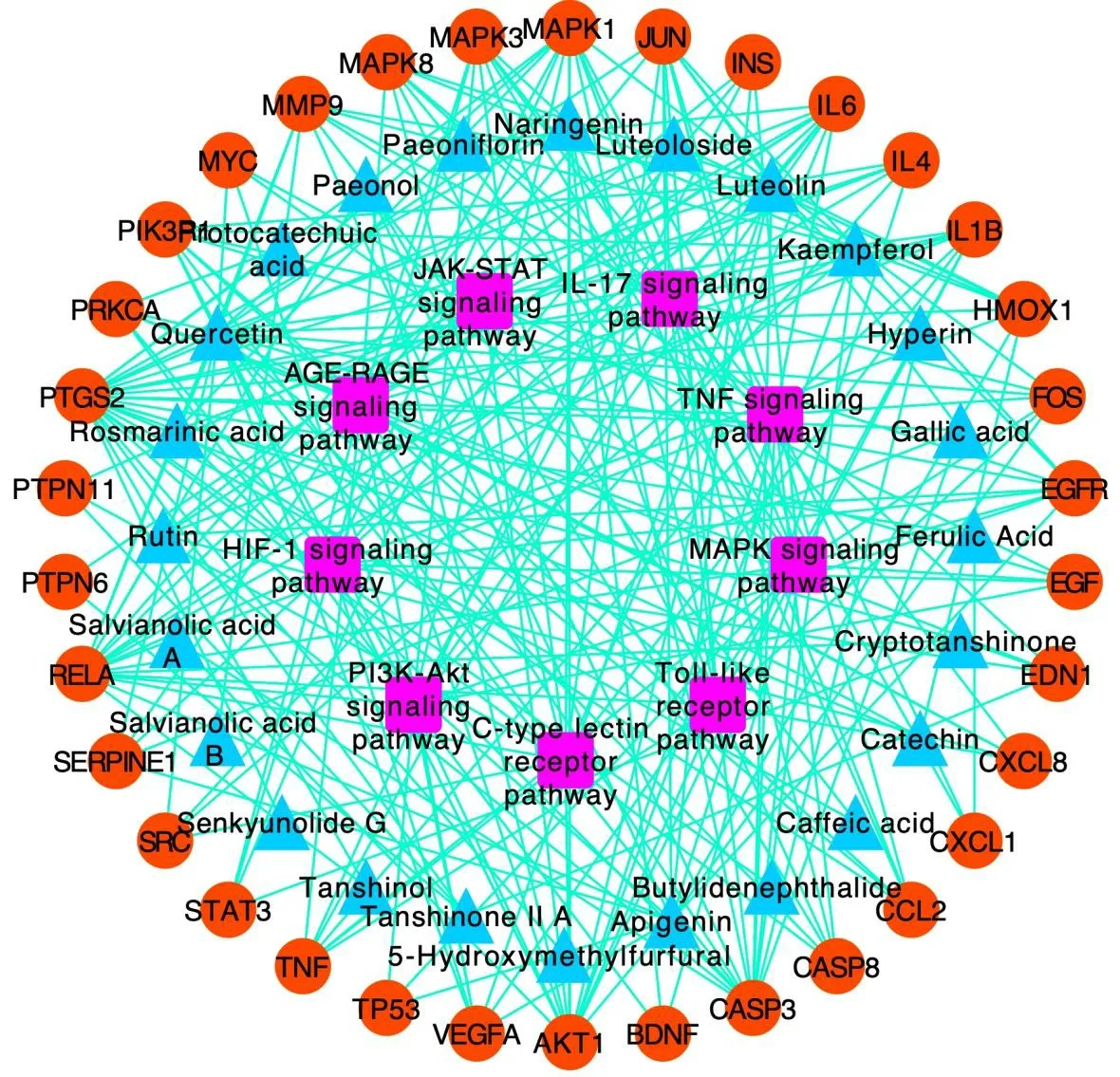
Figure 5.Compound-target-pathway (C-T-P) network analysis.The blue triangles represent major compounds,the orange circles represent core targets,the purple squares represent significant pathways,and the lines represent the interactions between them.
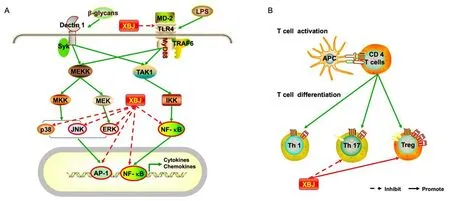
Figure 6.Simulation diagram of the effect of XBJ against sepsis during initial immune activation.(A) The representative pathways influenced by putative targets of XBJ ingredients in the immune system.(B) The effect of XBJ on T cell differentiation.The molecules marked with a red outline represent the identified core targets.

Figure 7.Simulation diagram of the effect of XBJ against sepsis during the acute inflammatory response.(A) The representative pathways influenced by putative targets of XBJ ingredients during the acute inflammatory response;(B) The effect of XBJ on the cytokine storm.The molecules marked with a red outline represent the identified core targets.
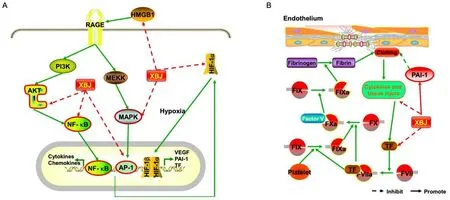
Figure 8.Simulation diagram of the effect of XBJ against sepsis during the late inflammation and coagulation process.(A) The representative pathways influenced by putative targets of XBJ ingredients during the late inflammation and coagulation process.(B) The effect of XBJ on the coagulation process.The molecules marked with a red outline represent the identified core targets.
Discussion
XBJ is the only medicine approved by the China Food and Drug Administration (CFDA) specifically for the treatment of sepsis.Despite extensive clinical and experimental studies that aimed to reveal the mechanism of XBJ against sepsis,the underlying multi-scale molecular mechanisms remain to be explored.In this work,a total of 33 major compounds with 218 putative therapeutic targets for sepsis were obtained.Through topological analysis,41 core targets were identified.Among them,IL-6 and TNF play important roles in the pathogenesis of sepsis and have been proven to be essential targets of XBJ [5,41,42].AKT1,STAT3,and MAPK1 are involved in the pathways induced by several stress signals,including inflammatory cytokines,oxidative stress,and activated oncogenes.In line with their biological processes,we divided the pathways into three functional modules as follows.
Initial immune activation
The host response to an infection is dependent on activation of the innate immune system.Cells of the innate immune system recognize microbial pathogenassociated molecular patterns (PAMPs) or damageassociated molecular patterns (DAMPs) through pattern-recognition receptors (PRRs) on the cell surface (Toll-like receptors and C-type lectin receptors),resulting in upregulation of inflammatory gene transcription and the initiation of innate immunity [43].
The Toll-like receptor (TLR) family is one of the best-characterized PRR families [44].Toll-like receptor 4 (TLR4),a member of the TLR family,binds to lipopolysaccharide (LPS) with the help of myeloid differentiation factor 2 (MD2) and plays an important role [45].LPS is an importance virulence factor of gram-negative bacteria and is known to be a principal factor in sepsis.Upon activation of TLR4 with LPS,MyD88 recruits Tumor Necrosis Factor-Receptor-Associated Factor-6 (TRAF6) and forms a complex with TGF-Beta-Activated Kinase-1 (TAK1).TAK1 directly phosphorylates the trimeric IκB kinase (IKK)complex,which activate NF-kappa B (NF-κB)signalling and lead to the production of inflammatory cytokines,such as TNF-α and IL-6.A study demonstrated that XBJ injection significantly reduced lung injury in rats through the downregulation of TLR4 and NF-κB expression [46].Cellular experiments revealed that XBJ can relieve the inflammatory response and reduce the TNF-α degree through the TLR4-NF-κB signalling pathway [47](Figure 6A).
Moreover,TLRs also phosphorylate mitogenactivated protein kinases (MAPKs) that result in the upregulation of inflammatory gene transcription [48].The MAPK signalling pathway,one of the most extensively studied intracellular signalling cascades,is a hierarchy of three kinase components: a MAPK kinase kinase (MAP3K),a MAPK kinase (MAP2K),and a MAPK [49].Activated MAPK converts extracellular stimuli into various cellular responses by phosphorylating diverse molecules,including transcription factors such as activator protein-1 (AP-1)[50].There are three main families of MAPKs: c-Jun NH2-terminal kinase (JNK),p38 MAPK,and extracellular signal-regulated kinase (ERK).Among them,JNK and p38 MAPK respond primarily to cellular stress and cytokines such as TNF and ILs to induce apoptosis,cytokine production,inflammation,and metabolism,while ERKs are activated by growth factors and contribute to cell growth and differentiation[51,52].Earlier reports revealed that the protective effects of Xuebijing on paraquat-induced acute lung injury and LPS-induced liver injury was realized by inhibiting the expression of p38 MAPK [53,54].However,our results suggest that regulating the expression of JNK and ERK may also contribute to the therapeutic effects of Xuebijing injection (Figure 6A).
C-type lectin receptors (CLRs) have recently been identified as an important family of PRRs that recognize glycans and glycoproteins located on the surface of pathogens in a Ca2+-dependent manner [55].CLRs trigger a variety of functions,including the cytokine response,the eliminate invading pathogens,and T cell activation [56].Dectin-1,a CLRs family receptor,is mainly expressed by monocytes,dendritic cells (DCs),and macrophages [57].Dectin-1 engagement by glucan leads to signalling via the spleen tyrosine kinase (Syk) pathway and triggers transcription factors,such as NF-κB and AP-1,which induce the expression of cytokine genes such as IL-6 and TNF [58].In addition,dectin-1 signalling leads to the expression of co-stimulatory molecules,which may induce CD4+T cells to further differentiate into Th1 or Th17 cells [59].This agrees with previous research,which suggests that XBJ improves survival in the context of septic shock by preventing the cytokine storm and regulating the balance of Tregs and Th17 cells [17].The results indicated that the C-type lectin receptor pathway may be a signalling pathway through which XBJ protects against sepsis (Figure 6B).
The acute inflammatory response
Activation of the immune system ultimately leads to the release of early inflammatory mediators.These cytokines,such as TNF and ILs,in turn,result in the phosphorylation of NF-κB,MAPKs,or signal transducers and activators of transcription (STATs) to initiate a cascade of other cytokines and chemokines,including IL-8,IL-17,CC-chemokine ligand 2 (CCL2),and CXC-chemokine ligand 8 (CXCL8) [2] (Figure 7A and B).
TNF-α,a pro-inflammatory cytokine,plays a pivotal role in the pathogenesis of sepsis and the cytokine storm.The serum levels of TNF-α are inversely correlated with the survival rate of patients with severe sepsis [60].TNF-α interacts with TNF receptors(TNFRs) to induce at least two cellular signaling complexes [61].The initial receptor-associated plasma membrane complex (complex I) causes immediate activation of NF-κB and MAPK,thereby promoting cytokine production and the immune response.The secondary cytosolic complex (complex II) results in the recruitment and activation of caspase to initiate cell death [62].Evidence suggests that XBJ can increase the survival rate of septic rats by reducing the levels of cytokines,such as TNF-α and IL-6 [41].In addition,Sun et al.found that XBJ attenuates apoptosis in rats with sepsis-induced acute kidney injury by reducing the expression of caspase-3 [63] (Figure 7A).
IL-17,which is mainly produced by T helper 17(Th17) cells,is not only an important cytokine for the clearance of pathogens but also a vital inflammatory effector for synergizing with other inflammatory signals [64].The IL-17 signaling pathway,which is common to the TLR/TNF pathways,also upregulates inflammatory gene expression by activating NF-κB and MAPK [65].In addition to regulating transcription factors,IL-17 synergizes with other cytokines by stabilizing target mRNA transcripts [64].In particular,IL-17 induces both positive and negative regulators of its own signaling pathways,which are vital to keeping inflammation under control [66].A previous study found that XBJ treatment normalized IL-17 expression in CD4+T cells in septic mice [17].However,in our current results,IL-17 is not a putative target of XBJ.We speculate that XBJ may regulate the IL-17 signaling pathway through transcription factors downstream of NF-κB and MAPK .
Furthermore,extracellular binding of cytokines to the corresponding receptors also stimulates the Janus kinase- (JAK-) signal transducer and activator of transcription (STAT) pathway,which is one of the major signaling pathways believed to be involved in sepsis [67].The JAK-STAT signaling pathway is related to the release of various cytokines and is involved in regulation of the immune response in sepsis[68].In addition,the JAK-STAT pathway has some negative regulators that modulate signaling,such as suppressor of cytokine signaling (SOCS),which limit STAT activity via inhibitory interactions with receptors and Jaks.A study revealed that the beneficial effect of XBJ in septic mice might be related to regulation of the JAK-STAT signaling pathway [69].Li et al.demonstrated that XBJ can significantly alleviate liver injury in septic rats by increasing SOCS1 expression[70] (Figure 7A).
The late inflammation and coagulation process
The JAK-STAT pathway represents a critical signaling mechanism in the secretion of high-mobility group box 1 (HMGB1),a late pro-inflammatory mediator in sepsis [71].HMGB1 is a nuclear non-histone DNAbinding protein and is probably known best as an archetypal alarmin or a typical DAMP molecule when released into the extracellular milieu [72].Extracellular HMGB1 acts as a chemotactic or pro-inflammatory mediator via interactions with receptor for advanced glycation end products (RAGE) [73].Although RAGE was originally identified as a receptor for advanced glycation end-products (AGEs),it is now well-accepted that RAGE binds to multiple ligands,many of which can be defined as DAMPs.In addition,the binding affinity between RAGE and AGEs is relatively weak in comparison with that between RAGE and other ligands,such as HMGB1[74].The HMGB1-RAGE pathway activates MAPK and NF-κB and amplifies inflammatory responses [75].In addition,phosphatidylinositol 3-kinase/protein kinase B(PI3K/AKT) is also involved in the HMGB1-RAGE pathway [76].Our results suggest that the AGE-RAGE signaling pathway is a core pathway by which XBJ protects against sepsis.To date,some scholars have proven that XBJ effectively downregulates the expression of HMGB1 and RAGE in septic mice compared with sham-operated mice [77,78].According to previous studies and our results,we speculate that the HMGB1-RAGE pathway may be the core pathway of XBJ in sepsis (Figure 8A).
The cytokine cascade has a profound effect on coagulation and the vasculature,resulting in activation of the coagulation system and ultimately tissue injury and organ dysfunction.A recent review suggested that hypoxia is a characteristic of organ dysfunction in sepsis [79].Hypoxia-inducible factors (HIFs),the only putative targets of hydroxysafflor yellow A in this study,mediate adaptive responses to hypoxia by regulating metabolic changes,such as aerobic glycolysis [80].Under hypoxic conditions,the endothelial HIF-1 signaling pathway induces the expression of proteins controlling coagulation and vascularization,such as pro-thrombotic tissue factor(TF),plasminogen activator inhibitor (PAI) 1,and vascular endothelial growth factor (VEGF) [81,82].A previous study showed that XBJ can inhibit the expression of HIF-l and its target gene in CLP-induced septic rats [83].Additionally,XBJ was found to suppress PAR1 and confer protective effects on endothelial barrier function both in vitro and in vivo in a heat-stress model [84].Chai et al.reported that XBJ treatment can markedly suppress the pro-coagulant activity of TF at the cellular level [85].Taken together,these studies may suggest that XBJ improves coagulopathy in sepsis through the HIF-1 signaling pathway (Figure 8A and B).
In summary,the present work systematically deciphered the underlying multi-target pharmacological mechanism of XBJ against sepsis using network pharmacology integrated with a literature screening approach.First,a total of 33 major compounds,including hydroxysafflor yellow A,ferulic acid,oxypaeoniflorin,albiflorin,and paeoniflorin,were screened out via a systematic literature review.Second,among the 218 overlapping targets,41 genes were identified as core targets.Third,the biological functions were mainly involved in cytokine receptor binding,cytokine activity,growth factor receptor binding,growth factor activity,and chemokine activity.Fourth,the signaling pathways related to sepsis in the current study were mainly associated with initial immune activation,the acute inflammatory response,and the late inflammation and coagulation process.
Conclusion
TCM has provided abundant and valuable experience in preventing and treating critical illness.This work suggested that the multiple components of XBJ exert multi-target effects against sepsis by regulating initial immune activation (the CLR/TLR4-NF-κB/MAPK pathway),the acute inflammatory response (the TNFMAPK/caspase and IL-MAPK/STAT pathways),and the late inflammation and coagulation process (the HMGB1-RAGE and HIF-1 signaling pathways).Our findings may offer potential insight into the mechanisms of XBJ in the treatment of sepsis.
Supplementary materials
Supplementary Figures and Tables
杂志排行
TMR Modern Herbal Medicine的其它文章
- Supplementary materials
- Systematic review on the adverse reactions of oral administration of Indigo Naturalis and its preparations
- A systematic review on the neuropharmacological activities of Oligosaccharide ester in Polygalae Radix
- Shiqi herbal tea reduces the susceptibility to H1N1 influenza virus in stressed mice.
- Study on the mechanism of Fructus Forsythiae and Folium Nelumbinis on acute pharyngitis based on network pharmacology
- The active ingredients of Huanglian Jiedu Decoction in treating COVlD-19 based on network pharmacology,molecular docking and molecular dynamics simulation
